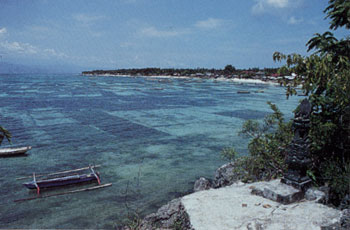 If reefs are to survive in many developing nations, the pressures on fishing must be relieved.In the waters near Bali, Indonesia, former fishermen have found a sustainable alternative livelihood by “farming” seaweed that is then sold to Japanese cosmetic and pharmaceutical firms. (Photo: Osha Gray Davidson) If reefs are to survive in many developing nations, the pressures on fishing must be relieved.In the waters near Bali, Indonesia, former fishermen have found a sustainable alternative livelihood by “farming” seaweed that is then sold to Japanese cosmetic and pharmaceutical firms. (Photo: Osha Gray Davidson)
CURWOOD: So what are the problems, what are some of the problems, associated with the loss of coral reefs?
DAVIDSON: If we destroy coral reefs we’re destroying the heart of biological diversity for the planet. And the awe that I felt when I was on the coral reef, you can read about that same awe in Darwin’s writings. And so many divers who have gone to reefs experience that same feeling of awe. And future generations deserve to have the opportunity to experience that also. Coral reefs are simply – they’re a large part of what makes this planet unique. They’re the jewel in the crown of the Blue Planet, and if we aren’t willing to save them, if we’re not willing to take the steps that are necessary to preserve them, I don’t know what in the natural world we could find that would be important enough to protect.
CURWOOD: Well I want to thank you for taking this time with me today. Osha Gray Davidson is author of “The Enchanted Braid – Coming to Terms with Nature on the Coral Reef.”
DAVIDSON: Thank you very much, Steve. It’s been a joy talking with you.
CURWOOD: Coming up after a short break, we’ll be joined by professor Ove Hoegh-Guldberg, who is the director of the Center of Marine Studies at the University of Queensland in Australia and is co-author of a study on climate change and the threat to Australia’s Great Barrier Reef. Stay tuned to NPR’s Living on Earth.
[MUSIC]
CURWOOD: Welcome back to Living on Earth, I’m Steve Curwood. Today we’re talking about coral reefs, and for the next part of our program we turn to Ove Hoegh-Guldberg. He’s the director of the Center of Marine Studies at the University of Queensland and co-author of a study on climate change and the threat it poses to Australia’s Great Barrier Reef. Professor Hoegh-Guldberg’s research indicates that the reef could die off entirely in the next 90 years. Some conservationists have labeled that possibility a global crisis and a nightmare for the planet. And Australians could expect to lose more than $2 billion a year that the Great Barrier Reef currently adds to their economy from tourism. Professor Hoegh-Guldberg is on the line now from Brisbane. Thanks for joining us.
HOEGH-GULDBERG: Hi, nice to be with you.
CURWOOD: Tell me, how did you get interested in coral reefs anyway?
HOEGH-GULDBERG: Well, I can trace my interest in coral reefs back to a trip I made with my Danish grandfather, who went to the Great Barrier Reef as a tourist and as a butterfly collector. We went for a snorkel, and this was 1969 when, I guess, men were on the moon, and I got to the reef. And it was really, ah, I can still remember sort of entering the water and seeing my first butterfly fish, you know, which had significance for my grandfather. Yeah, from thereafter I hungered after getting up to the reef, or going below the water in Sydney and imagining I was on a coral reef.
CURWOOD: Now, who’s your co-author on this project?
HOEGH-GULDBERG: Hans Hoegh-Guldberg, who is actually my father. And he’s an economic forecaster, has written many, many reports on things like, what is tourism going to do in the future and so on. And so it was a natural partnership for us to try to ponder the future of a very complex economic and social phenomenon, which is the Great Barrier Reef.
CURWOOD: If you had to describe a coral reef, how would you describe it?
HOEGH-GULDBERG: I suppose it is very much like the most amazing metropolis, full of, you know, clowns and artisans that are doing things in ways which sort of defy almost what you’ve been taught about in terms of evolution. And so when you see parrotfish going across the reef that are painted pink and bright green -- and that’s the result of natural selection -- you have to go, “Wow! You know, what function does that have?”
And it’s only when you delve into it do you realize that all of these sort of signals, and the things we’re picking up on, are actually very finely tuned adaptations. You know, the parrotfish is trying to show off how dominant he is over his band of females that he rules over. So, it’s a funny place, because at first it seems impossible, but then when you get to know the million species – and it may be as much as nine million species living on coral reefs around the planet – each has a special and finely crafted position within that ecosystem.
CURWOOD: And how is it that you came to decide you wanted to do a study about climate change and coral reefs?
HOEGH-GULDBERG: Well, my interest in climate change was quite accidental. I did my Ph.D. at UCLA in Los Angeles, and I started studying a phenomenon known as coral bleaching. This was in the early to mid ‘80s, and at that point we didn’t really know what this phenomenon was. All we knew was that reefs off Florida and the Caribbean had been going white over large areas. And in studying that I, by the end of my Ph.D., had sort of come to the conclusion that, like some early authors in the ‘70s, a small change in temperature can cause this phenomenon. And in fact, by that time satellite experts at NOAA and Washington and so on were reporting a great correlation between bleaching and sea temperature rise, and what we were seeing was the first signs of climate change.
CURWOOD: Now you’ve just finished a report on the impact of climate change on Australia’s Great Barrier Reef. Can you tell us about what’s in your study and what you found?
HOEGH-GULDBERG: Well one of the most important aspects of climate change -- you know, the large scale mass destruction, for example, that we saw in 1998 when we lost 16 percent of the world’s corals -- we get to the point where we say, well so what? Are corals important? And so what we tried to do with this report was to take the perspective on what’s happening to reefs to that very important level of the socioeconomic ramifications. What does it mean for Australia if the Great Barrier Reef no longer has coral on it? And to do that you really need to evaluate the importance of coral, and when you do that you actually come up with some surprising sort of facts about how dependent a lot of the local economies in Australia are to the Great Barrier Reef.
CURWOOD: Now, Australia is one of a very few industrialized countries that have yet to ratify the Kyoto Protocol. Russia hasn’t, although recently Mr. Putin in Russia said he would. The United States hasn’t, and Mr. Bush has said pointedly he will not. And Australia hasn’t. Do you think that your report is going to change any minds there in Australia about the Kyoto Accord?
HOEGH-GULDBERG: Well, I think it’s part of a fabric that we have to build up. Because I think up until probably the last couple of years, I think politicians have been able to avoid the idea that there are great costs of not responding to climate change. And I should say that the various ministers that are involved with looking after the Great Barrier Reef have actually been quite responsive to the report. And there is a sea change I think happening within the Australian political scene where people are starting to realize that isolationism, which is essentially what not signing Kyoto amounts to, will not work in the long run.
And so I think that when people are actually told that well, it could be an $8 billion cost over 19 years, and that’s just the real minimum part of this cost in terms of the effect of climate change on the Great Barrier Reef alone. And you start to add up the effect on rainforests and you start to look at the impacts on agriculture and water availability, you start to see that the costs of not responding are much, much larger than the costs of responding.
CURWOOD: Now professor Hoegh-Guldberg, let me ask you this. In your report you state that only if global average temperature change is kept to below two degrees Celsius can the Great Barrier Reef have any chance of recovering from the damage that’s being predicted here. And I’m wondering how likely you think it is that, in fact, we can keep temperatures from rising more than that here on earth?
HOEGH-GULDBERG: That’s one of the more tricky scenarios, unfortunately, trying to keep the temperature from rising more than two degrees. That’s the lower end of the intergovernmental panel on climate change, which is that huge body of scientific credibility that have come up with future scenarios. That two degrees is at the bottom range. I mean, the more likely range that we’re going to hit by the end of this century is about four degrees. And so you’re right, it’s a very tricky thing that we have to achieve here.
But I think unless we understand what the goal is, I mean we can’t – science has to deliver the truth to society, I think, about what the state of opinion is, and what we think is where we need to go in terms of this. If we don’t, of course, then we’re kidding ourselves. So I think we’ve got to really call it as it is, and then I think we’ve got to look at what we can do socioeconomically. I mean, we are an amazing species, to put it bluntly. What technologies we may dream up in the next few decades may totally change the perspective on what we can actually achieve.
CURWOOD: In your report you talked about the importance of the reef having ecological resilience in order to survive the impacts of climate change. And just recently your environment minister there in Australia – David Kemp is his name, I have that right?
HOEGH-GULDBERG: That’s right.
CURWOOD: I believe he announced that he’s going to increase the protective zones on marine sanctuaries in the Great Barrier Reef from four percent to something like 30 percent or a third, something like that?
HOEGH-GULDBERG: Well, the good news is that that’s been passed, so the Great Barrier Reef, which only had 4.6 percent in no-take zones, now has 32.5 percent of the reef protected from any sort of extraction. So that process that we went through last year was really one of the, I think, one of the great success stories of conservation. And it came about using the sort of societal pressures – I mean everyone loves the Great Barrier Reef in Australia and I think people were quite shocked when they found out that only 4.6 percent was actually in no-take zones, you know, complete protection zones. Because everyone had assumed that if it’s the Great Barrier Reef Marine Park that must certainly mean that it’s all protected. Um, I was just going to go back to that question of reef resilience –
CURWOOD: Yes.
HOEGH-GULDBERG: That question is a very interesting because one of the outcomes early in the piece -- and it was sort of almost sort of, you know, a tragic debate, if you like. People would say well look, if reefs are all stuffed because of climate then why are we bothering to, you know, reduce the impact of industry on coastlines that have coral reefs? And why are we trying to solve sediment problems in rivers and agricultural run-off? And the answer actually is that those other issues are even more important now because of the following issue, and that is that we know that reefs that get affected by this phenomenon of coral bleaching will recover faster if we’re not impacting them with all these other issues. If we’re not hitting them with huge amounts of sediment when they’re bleached they’ve got a good chance of bouncing back. And that’s what reef resilience is all about. It’s about how quickly you can get up after you’ve been knocked down.
Now, of course, if you are being beleaguered by a whole series of other stresses then your ability to get back up off the ground after a climate event, of course, is small. So reef resilience, conservation of reefs, is even more important than it was before the realization of the climate threat. I mean, now we really should be looking at these large no-take zones, because we’ve got to leave reefs with as many options, if you like, for bouncing back from bleaching events. Let’s go back to the parrotfish, the garish parrotfish walking--swimming across the reef. They actually play an important role in keeping the algae at bay, right? They eat algae, so they’re cropping coral reefs all the time. And when you have a bleaching event and you have parrotfish then the parrotfish essentially keep the bottom of the ocean open for the settlement of corals and so on. Now if you don’t have the coral—if you don’t have those parrotfish you don’t have the gardeners, and you have a bleaching event. Then the algae have been observed to go wild, you know: Corals die off, the algae settle onto the dead corals, the parrotfish aren’t there to eat them, and essentially what happens is the reef changes to an algal-reef. And of course that’s a very graphic example of why you need MPAs and these large no-take zones, you know, time of climate. We need as many options, many components of coral reefs to make sure that they can bounce back after periodic periods of stress.
CURWOOD: Ove, I wonder if you thought when you got into science that you would have to do so much politics?
HOEGH-GULDBERG: That is a very good question. I had no idea (laughs) and it came down to…I think—you know I saw my grandfather, this lepidopterous butterfly collector, and you know he would spend his days sort of looking at his collections and writing papers on, you know, what was going on with the butterflies and so on. And I used to look at the historic figures like McClay, who was a guy who operated out of Australia in the 1800s which were academics and they would literally be pondering on biology by the day and probably taking tea at the regular hour and so on. But the way biology’s gone now is that we’ve been linked into these incredibly important debates. When you are talking about, you know, the prospect of a massive decline in these beautiful ecosystems – which, when you put a number on them in terms of tourism and fisheries, that’s really overlooking the fact that it’s really an art treasure which you can’t cost – and when you’re faced by this you find that you’re compelled into having to provide scientific opinion. And in some ways to enter into the game of politics because it becomes so important. That’s where the action is. Yeah, no, I had no idea.
CURWOOD: We need to go, but tell me – I’ve actually never been to the Great Barrier Reef -- how much time do I have--
HOEGH-GULDBERG: That’s sinful!
CURWOOD: How much time do I have to get down there to see it the way it should be seen?
HOEGH-GULDBERG: Well, I think we’ve got a good few decades left, and it really depends on what your and my country do in terms of controlling greenhouse gas emissions, but I’d say you’ve got a good decade or two. It depends on, obviously—look, this is so beautiful I can’t believe you haven’t come down here and seen it! I mean it really is one of the most spectacular treasures, and Osha did a very good job I think of describing going over the reef crest. And I mean that’s just the beginning of the journey. I mean when you get down to 30 meters and you see these soft coral gardens that are really like some Lewis Carroll manifestation – you know the pinks and greens and strange fish that sort of poke out, you know they poke their faces out and then disappear and then strange shellfish try to sort of catch your eye – it really is—look, you’ll have to come down to Heron Island and I’ll host you, ok? There’s an offer on radio.
CURWOOD: Well, how can I turn that down?
HOEGH-GULDBERG: Well, I hope you won’t.
CURWOOD: Ove Hoegh-Guldberg is co-author of “The Implications of Climate Change for Australia’s Great Barrier Reef” and he’s the director of the Center for Marine Studies at the University of Queensland in Australia. Thanks for taking so much time with me today.
HOEGH-GULDBERG: Oh, it was very much a pleasure. Thank you.
[MUSIC]
CURWOOD: You can hear our program anytime on our website. The address is Living on Earth dot org. That’s Living on Earth dot org. You can reach us at comments at loe dot org. Once again, comments at loe dot org. Our postal address is 20 Holland Street, Somerville, Massachusetts, 02144, and you can call our listener line at 800-218-9988. That’s 800-218-9988. CDs, tapes and transcripts are $15.
Back to top
CURWOOD: Just ahead: one man’s roadkill is another man’s trophy—that is, if you’re a taxidermist. First, this note on emerging science from Susan Shepherd.
[SCIENCE NOTE THEME]
SHEPHERD: If we had the same sweat glands as the hippopotamus, we’d have little use for the sun blocks and anti-infection creams cluttering our medicine cabinets. Japanese researchers studying the secretions of Hippos say these hairless river horses literally sweat sunscreen. And this slow-setting lather doesn’t just protect them from the hot equatorial sun – it doubles as an antiseptic to help heal wounds as well.
Scientists at the Kyoto Pharmaceutical University in Japan recently discovered the sweat salving powers by analyzing swab samples taken from Hippos at a Tokyo zoo. They found the Hippo sweat is made up of two pigments – one red, called “hipposudoric acid”, and the other orange, dubbed “norhipposudoric acid.”
At first the Hippo’s sweat is a colorless, sticky liquid, but it gradually turns blood red and then darkens as the pigments bond to form a polymer. This plastic shell of sorts that absorbs ultraviolet light, just like commercial sunscreens. Scientists found the red pigment also makes a good antibiotic, which may explain why Hippos, when nicked and cut from their frequent scraps with rivals, don’t seem to get infections. But researchers are not rushing to parlay this sweat science into any human-friendly skin applications. That might be because Hippo body odor is far smellier than our own.
That’s this week’s note on emerging science, I’m Susan Shepherd.
[SCIENCE NOTE THEME]
CURWOOD: And you’re listening to NPR’s Living on Earth.
ANNOUNCER: Support for NPR comes from: NPR stations, and Aveda, an earth-conscious beauty company committed to preserving natural resources and finding more sustainable ways of doing business. Information available at Aveda dot com; The Noyce Foundation, dedicated to improving Math and Science instruction from kindergarten through grade 12; The Annenberg Foundation; and The Kellogg Foundation, helping people help themselves by investing in individuals, their families, and their communities. On the web at w-k-k-f dot org. This is NPR -- National Public Radio.
[MUSIC]
Back to top
CURWOOD: It’s Living on Earth. I’m Steve Curwood.
Generally death is the end of the line for most creatures, but not if their skins fall into the hands of a taxidermist. Taxidermy is the art and science of stuffing and preserving animals. It’s been around since the days of hunting and gathering. A good stuffed specimen should look every bit as life-like as the real McCoy.
Now it used to be that all one needed was a good eye and a weak nose to work the craft. Those are still needed, but these days taxidermy has gone high tech with plastics, and the friendly competition among practitioners has gotten stiff. Recently the Maine State Association of Taxidermists gathered in Newport, Maine, for it’s annual convention and taxidermy competition. Living on Earth’s Jennifer Chu was there and has our report.
[sound of setting up display, nailing coyote to a rock]
YORK: Mitch, run over and ask somebody if they got a three-quarter inch socket.
CHU: Larry York is doing some last-minute fluffing and combing. He’s just hauled in a vanload of turkeys, deer and wild boar that he’s preened and perfected over the past year. Right now, he’s setting up his piece de resistance – a North Carolina bobcat that’s leaping towards a baby fawn.
|
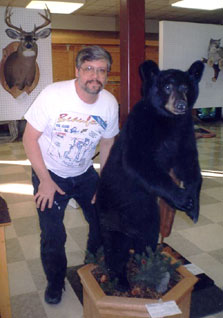
|
 |
 |
The Maine Association of Taxidermists’ President Mark Russell crouches by his black bear entry. (Photo: Jennifer Chu) 
|
|
A North Carolina bobcat in mid-leap towards a baby fawn. (Photo: Jennifer Chu) 
YORK: He’s gonna be hanging right from that leg. Like he’s jumped off the top of this rock and this is lunch going by.
CHU: York is one of two dozen taxidermists who hope to take home a trophy from this weekend competition. It’s also a chance for normally solitary artisans to swap some stories and get some tips.
RUSSELL: Don’t move the bird that’s on the leaf there. (right.) Last thing I wanna see is breaking it.
CHU: It’s Mark Russell’s last day as head of the Maine Association of Taxidermists - a title he’s held for the past three years.
RUSSELL: Yah, we’re not a tight-knit group, but you know we’re friends, and we talk with each other and the stories will be flying. Generally it’s hunting stories and the piece that you mounted and how you did it, but generally we’re all a good group of guys, and we’re all here really to have a good time.
CHU: Tomorrow he’ll hand the presidency over to his friend John Wardwell, a fellow taxidermist who’s been in the business for 15 years. But for now, they’re just two guys checking out the competition.
RUSSELL: This is a muddy pig, what did you bring in a muddy pig for? (laughter) It’s kind of a neat idea.
WARDWELL: yeah, work like hell to get him clean and look nice and everything and then you splatter mud all over him. What’s up with that?
CHU: Just behind this pig is Wardwell’s sparkling clean entry: a boar’s head that, if seen from the right angle, looks like it’s got a secret. Wardwell has a few secrets of his own that he says puts him ahead of the game.
WARDWELL: The last and final cleaning when I do a fur-bearing animal, especially the bear, I use Windex. Wash them with good with Windex and then fluff them with a hairdryer, and it makes them look just like they come in out of the woods…all freshed up after a rainstorm.
CHU: Did you do that with your boar, too, today?
WARDWELL: He got washed with Fantastik, believe it or not. And he smells pretty. He’s a handsome boy (laughs).
CHU: Many of these taxidermists have worked on their pieces for months, and some even up to a year. It’s a craft that takes infinite patience, and many spend days fitting glass eyes or flaring nostrils just right. For Wardwell, it was the boar’s dental work that kept him up nights.
WARDWELL: I think the biggest problem I had was the gums that show along his teethline – that really flesh-toned inside of the mouth and then as they move up to the hairline they gradually get darker and darker and darker, so you kinda gotta blend your paints from flesh to a burnt umber color.
CHU: It’s at this moment that the taxidermist sounds like any suffering artist - frustrated by the chasm between his subject and his work. For early taxidermists, it was even harder to bridge that gap. As Wardwell and Russell wait for more entries to file into the showroom, they chat up their friend Steve Gilboe, who recently got his hands on a taxidermic relic.
RUSSELL: Y’know, you gotta to be careful with some of them old mounts--
GILBOE: Oh, I bet.
RUSSELL: --cuz some of ‘em were pickled in formaldehyde.
GILBOE: It was, it was very powdery, once you cut it open it was all real powdery. And this guy had wrapped it, there was some chicken wire in it, and they had wrapped some newspaper and everything. And it was nice!
CHU: Back then, taxidermists improvised with anything they had at hand, from cotton balls to wood shavings. And according to Mark Russell, they’d even employ Nature herself.
RUSSELL: Well back years ago, before there were forms, they’d put the skull out on an anthill or something and the ants or the bugs would clean it out, or they could boil the meat membrane off and they would actually reuse the skull and the lower jaw.
CHU: These days, instead of stuffing a skin with newspaper, you can order a plastic form of any number of species, and choose from a variety of poses. You can then use a custom glue to fit your hide over the mold. Though it may seem like all this technology only makes the work easier, some say it’s served to raise the bar in terms of workmanship. A recent issue of the popular trade magazine Taxidermy Today is chock full of ads for hide paste, critter clay, and Styrofoam mannequins. There are also notices of apprenticeships and special trade schools. And just a floor above the competition’s showroom is the country’s only high school taxidermy class.
MCAVOY: Oh I wasn’t sure when I first come into the program, I was kinda, “I don’t know if I can do it,” but as I went on, I got used to it. Sometimes the smell, mmmm, it’s a little gross, but you get over it.
CHU: Mallory McAvoy is a junior at Nokomis High School. It’s her first year in this classroom, which, from the outside, looks like any other high school science lab. Except that inside, the tables are filled with plastic animal parts, and boxes of furs and skins.
(rustling in freezer)
MCAVOY: See this is one of our freezers, pretty full of animals. Usually the projects we’re working on we put in here.
CHU: Mallory fishes out her current project: Hector, her recently-deceased pet pheasant.
|
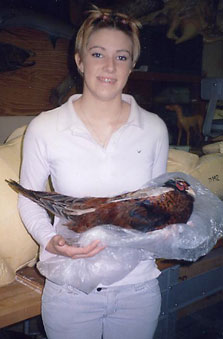 Mallory McAvoy with her current project: Hector, the family pheasant. (Photo: Jennifer Chu) Mallory McAvoy with her current project: Hector, the family pheasant. (Photo: Jennifer Chu) 
|
 MCAVOY: He’s nice and fat, and I think he died of old age, but we’re not sure. He’s pretty, so I’ll be doing him sometime, getting some ideas from downstairs to see how I wanna pose him.
MCAVOY: He’s nice and fat, and I think he died of old age, but we’re not sure. He’s pretty, so I’ll be doing him sometime, getting some ideas from downstairs to see how I wanna pose him.
CHU: Mallory’s teacher is Howard Whitten, a man dressed in blue overalls, with a habit of picking up roadkill for possible student projects. He started the class ten years ago, and says he’s taught every kind of kid there is.
WHITTEN: I will say this, in ten years the girls are the best. They kick butt (laughs). For instance, if I brought a girl and boy and had them look at a deer, first thing out of the boy’s mouth would be, “Look at the rack, look at those horns, look at the antlers.” The girl, it’s usually, “Aww, look at the eyes. Look at that mouth.”
CHU: But take a look at the two dozen or so taxidermists who have come to compete downstairs, and there’s not a woman among them. And even though Whitten says there’s no gender barrier in his classroom, history of the field was very exclusive.
WHITTEN: Historically, taxidermy has been a real secretive clique of men that won’t invite anybody into their shop, they don’t want to divulge any secrets. Historically, museums only employed men to do all the taxidermy displays.
CHU: There are few requests for such elaborate displays today. Places like Harvard’s Natural History Museum have sizeable collections, mostly acquired decades ago. Judy Chupasko is a curator in the museum’s mammal department. She says that some exhibits are starting to show their age.
CHUPASKO: The giraffe is incredible (walks down stairs), it’s a huge giraffe. But you can see he’s kinda busting out of his seams here…poor guy looks like he’s out in the savanna, doesn’t he? And he needs water really bad (laughs).
CHU: Chupasko estimates this giraffe was stuffed 150 years ago, when the country’s museums and the public couldn’t get enough of taxidermy.
CHUPASKO: I think back in the 1800s when a lot of naturalists were trying to describe and define species, and new species, and they were traveling all over the world, it was a whole different mentality than probably now, but that’s because it was a different place and time.
CHU: It was Darwin’s “Origins of Species” that really vaulted the field into its Golden Age. When the book hit shelves in 1859, it seemed everyone wanted a piece of nature; the educated elite more so than anyone. Perhaps the pinnacle of taxidermy came in 1916, when one of its most famous students, Carl Akeley, was accepted into the National Institute of Social Sciences. The occasion was for, quote, “making taxidermy one of the arts.” Judy Chupasko says today’s science of animal stuffing is quite a different field.
CHUPASKO: I don’t think we’ve had a taxidermist on staff in the museum for probably 50 years. I’m pretty much as close as you get to that and I’m not a taxidermist (laughs). But we could figure out who to talk to, to get things done if we needed to.
(phone rings)
FOURNIER: Creative Taxidermy.
CHU: Brad Fournier occasionally gets calls from local schools and museums, but as with most taxidermists, the work that pays the bills comes from hunters.
FOURNIER: Sportsmen have big egos a lot of times, and if they bring in a fish or a deer, they’re having it mounted because it’s was a large one and they’re trying to display how big it was. Usually with a fish, the fatter you can make the belly, or the larger you can make the neck on a deer mount makes a customer pretty happy.
CHU: Fournier took up taxidermy as a kid. It started with a how-to book from the library. He later enrolled in the Pennsylvania Institute of Taxidermy, and now has a full-time business in Haverhill, Massachusetts, at the back of his parents’ house, where he also lives upstairs.
FOURNIER: The commute’s great. Can do it in slippers.
CHU: Right now, he’s fitting a deerskin over a foam mold - a popular form that’s known as the "right-turn semi-sneak." He’s sewing up the back of the animal, and watching him work is a little like watching a tailor.
(cranks stand)
FOURNIER: Needs a little oil on that thing.
CHU: At a certain point, do you kind of forget that you’re working on an animal?
FOURNIER: Yeah, I think so, yeah, I guess it is almost like doing upholstery at some point, especially when you’re sewing up the leather like this. And, uh, you can almost do it without really thinking about it. This one’s pretty much ready to fly.
CHU: In fact, every year he files his taxes, Fournier says he has to list his business under upholstery. And while the IRS may not recognize the trade, there are some 70,000 taxidermists in the country today. Ten percent are fulltime, and the other ninety could spend up to 40 hours a week on the craft, even while holding down another job. There seems to be growing interest in the field -- you can even find a taxidermy show on cable television. (fade music before)
|
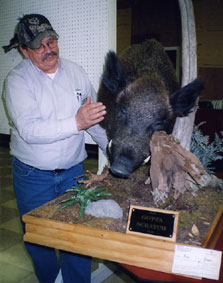
|
 |
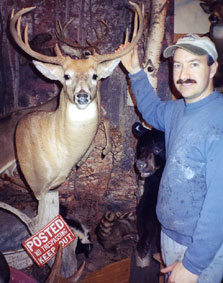 |
John Wardwell gives a final cleaning to his boar’s head. (Photo: Jennifer Chu) 
|
|
Brad Fournier shows off his showroom at Creative Taxidermy. (Photo: Jennifer Chu) 
(TAXIDERMY TRAILS THEME SONG) Have you seen the show about the guy that travels woods and lakes? He teaches how to taxidermy everything he takes. He paints a fish so lifelike that it could swim away, just so you remember that very special day.
CHU: Taxidermy Trails made its debut on the Outdoor Channel this past January. It’s aired on a network that primarily focuses on hunting and fishing, and the show’s producers say it’s the first time the ins and outs of taxidermy have been shown to a national audience.
(BANTLEY TEACHING TAXIDERMY ON SHOW) After the skin dries, the thick and plumpness of the nose pad dries down. So most often the taxidermist can rebuild the texture, and make the nose nice and full, just like a live deer.
CHU: Dan Bantley is the show’s host and creator. Speaking in a recent phone conversation to Living on Earth, he said while much of his fan mail comes from fellow hunters, other letters are from fans he didn’t expect.
BANTLEY: We’ve got a lot of emails from people’s wives saying, “I’ve been watching the show with my husband.” It didn’t set out originally to be like that, but we wanted to appeal to a broad scope of viewers.
CHU: Bantley’s show might just be the thing to bring husbands and wives closer together – that is, if one is into stuffing animals. Living with a taxidermist could present certain tests of loyalty. There’s the smell of chemical preservatives, and the inevitable clutter of accumulated mounts. Back at the competition in Maine, Tom Berube is known to his friends and colleagues as "The King of Birds." But his wife might have a different opinion.
BERUBE: She’s gotten mad a few times, like the time she walked in and I was taking a bear out of the washing machine. You know, I guess I had gone too far. But I still use the family washing machine to spin-dry bird skins.
CHU: Fluffing a bird’s tail feathers through the spin cycle may seem excessive and a bit eccentric. But it’s this technique that’s earned Berube his title. He also has the trophies to prove it. Today, he’s just here to offer moral support, as his friends await their final scores.
BERGANE: Number 45… ok, correct use of paints…hmmm, I don’t know what you call it, he’s got like scratches in his paint.
CHU: Mike Bergane is one of two judges at this competition. For the past two hours, he’s brandished a flashlight on dozens of birds, making sure each feather is in place. He’s even sniffed a few of them, to make sure no rot has taken root. As for deer…
BERGANE: It has to have the accurate nostril shape of the interior of the nose, coloring, texture, inside the ears, down where the ear canals meet the skull has to be accurately reproduced. We’ve taken it to a level now where, some of the judges like to joke that you could bring in a live deer and it wouldn’t do very good in competition (laughs) because some of these judges are looking for such detail.
CHU: While the judges make their final decisions, a few taxidermists pace outside. It’s Gordon Foster’s first time competing. As he awaits his score, he mentally lists all the things he could have done better.
FOSTER: A lot of guys here, like myself, already know their mistakes. But it’s like a carpenter. You can go into a house and see the finished job and it’ll look great to you, but the person who did the carpentry work knows the little cut here he made here, or a little mistake there, so…I let the dice roll where they gotta.
(door opens, paper crumbles)
RUSSELL: We’re open.
CHU: As the competitors file in, the judges steady their stance. It’s the moment Mike Bergane calls "the fun part”: when the judges get to tell the competitors what they could improve. At the moment, the other judge, Mike Vickerson, is evaluating Gordon Foster’s work.
|
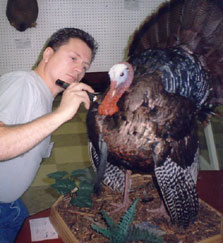
|
 |
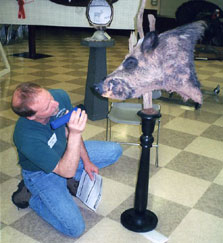 |
Judge Mike Bergane makes sure each turkey feather is in place. (Photo: Jennifer Chu) 
|
|
Judge Mike Vickerson gives more than a once-over for this muddy pig. (Photo: Jennifer Chu) 
VICKERSON: Ok, on your nose, you’re pretty good on the inside. You’re a little short, I don’t know how to explain it. Janey, wanna grab my freeze-dried nose? The nose on top of my bag? And look here too, you see where the leather is? That leather should be right on the edge. He’s a big freakin’ animal, I’ll tell ya that.
 A stuffed moose takes first prize at the Maine Association of Taxidermist’s annual competition. (Photo: Jennifer Chu) A stuffed moose takes first prize at the Maine Association of Taxidermist’s annual competition. (Photo: Jennifer Chu)
CHU: It’s not a bad review, and Foster says he’s happy with his second-place white-tail deer. With a little feedback from his fellow taxidermists, he might just snag first prize next year.
For Living on Earth, I’m Jennifer Chu in Newport, Maine.
VICKERSON: Uh, if you wanna straighten these edges they get like that, you can always take a steamer. You know a little hand steamer? (fade out)
[MUSIC]
Related links:
- Maine Association of Taxidermists
- National Taxidermists Association
- Taxidermy Trails Back to top
CURWOOD: And for this week - that's Living on Earth. Next week – does the mountain lion still roam the eastern United States?
[Mountain lion growl, hiss]
CURWOOD: This one does, but only behind the fence of an animal sanctuary. Most scientists say the mountain lion was wiped out in the east early in the last century. But nonetheless every year, hundreds of people report seeing the big cats.
BETTY: I’m not guessing that there are mountain lions in New England or I’m not supposing—I know they’re here. I’ve seen them for 30 years.
CURWOOD: Following the trail of the eastern cougar – next time on Living on Earth.
And between now and then you can hear us anytime and get the stories behind the news by going to Living on Earth dot org. That’s Living on Earth dot org.
[Why do whales and children sing? Cut #8]
Before we go, we witness some moments between predator and prey. A raven in flight scopes out frogs in Black Lakes, New Mexico. Recordist David Dunn captured these sounds.
EARTHEAR:
[Why do whales and children sing? Cut #8]
CURWOOD: Living on Earth is produced for the World Media Foundation by Chris Ballman, Christopher Bolick, Eileen Bolinsky, Jennifer Chu, Ingrid Lobet, Susan Shepherd and Jeff Young.
Our interns are Jennie Cecil, Diana Schoberg, and Monica Wright. You can find us at Living on Earth dot org. Our technical director is Paul Wabrek. Al Avery runs our website. Alison Dean composed our themes. Special thanks to Ernie Silver and Carl Lindemann. Environmental sound art courtesy of EarthEar. I’m Steve Curwood. Thanks for listening.
ANNOUNCER: Funding for Living on Earth comes from the National Science Foundation, supporting coverage of emerging science; and Stonyfield Farm – organic yogurt, cultured soy, and smoothies. Ten percent of their profits are donated to support environmental causes and family farms. Learn more at Stonyfield.com. Support also comes from NPR member stations, the Ford Foundation, for reporting on U.S. environment and development issues, and the Geraldine R. Dodge Foundation.
ANNOUNCER: This is NPR, National Public Radio.
Living on Earth wants to hear from you!
Living on Earth
62 Calef Highway, Suite 212
Lee, NH 03861
Telephone: 617-287-4121
E-mail: comments@loe.org
Donate to Living on Earth!
Living on Earth is an independent media program and relies entirely on contributions from listeners and institutions supporting public service. Please donate now to preserve an independent environmental voice.
NewsletterLiving on Earth offers a weekly delivery of the show's rundown to your mailbox. Sign up for our newsletter today!
 Sailors For The Sea: Be the change you want to sea. Sailors For The Sea: Be the change you want to sea.
 The Grantham Foundation for the Protection of the Environment: Committed to protecting and improving the health of the global environment. The Grantham Foundation for the Protection of the Environment: Committed to protecting and improving the health of the global environment.
 Contribute to Living on Earth and receive, as our gift to you, an archival print of one of Mark Seth Lender's extraordinary wildlife photographs. Follow the link to see Mark's current collection of photographs. Contribute to Living on Earth and receive, as our gift to you, an archival print of one of Mark Seth Lender's extraordinary wildlife photographs. Follow the link to see Mark's current collection of photographs.
 Buy a signed copy of Mark Seth Lender's book Smeagull the Seagull & support Living on Earth Buy a signed copy of Mark Seth Lender's book Smeagull the Seagull & support Living on Earth
| | | | |

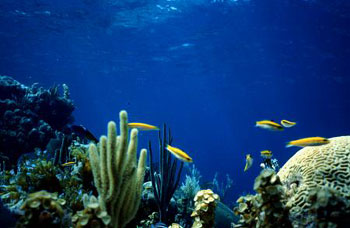 The clear, clean waters of the Bahamas include many healthy coral reefs such as this site at Sandy Cay Reef, Abaco, Bahamas. (Credit: Craig Quirolo)
The clear, clean waters of the Bahamas include many healthy coral reefs such as this site at Sandy Cay Reef, Abaco, Bahamas. (Credit: Craig Quirolo) 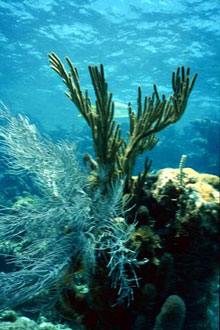 Sunlight is essential to the healthy growth of corals because it enables photosynthetic activities to occur in the zooxanthellae, a symbiotic algae that lives within the host coral and processes it waste products. The clear waters at this reef allow the sunlight to reach the corals. Sandy Cay Reef, Abaco, Bahamas (Credit: Craig Quirolo)
Sunlight is essential to the healthy growth of corals because it enables photosynthetic activities to occur in the zooxanthellae, a symbiotic algae that lives within the host coral and processes it waste products. The clear waters at this reef allow the sunlight to reach the corals. Sandy Cay Reef, Abaco, Bahamas (Credit: Craig Quirolo)  If reefs are to survive in many developing nations, the pressures on fishing must be relieved.In the waters near Bali, Indonesia, former fishermen have found a sustainable alternative livelihood by “farming” seaweed that is then sold to Japanese cosmetic and pharmaceutical firms. (Photo: Osha Gray Davidson)
If reefs are to survive in many developing nations, the pressures on fishing must be relieved.In the waters near Bali, Indonesia, former fishermen have found a sustainable alternative livelihood by “farming” seaweed that is then sold to Japanese cosmetic and pharmaceutical firms. (Photo: Osha Gray Davidson) 

 Mallory McAvoy with her current project: Hector, the family pheasant. (Photo: Jennifer Chu)
Mallory McAvoy with her current project: Hector, the family pheasant. (Photo: Jennifer Chu) 



 A stuffed moose takes first prize at the Maine Association of Taxidermist’s annual competition. (Photo: Jennifer Chu)
A stuffed moose takes first prize at the Maine Association of Taxidermist’s annual competition. (Photo: Jennifer Chu) 



